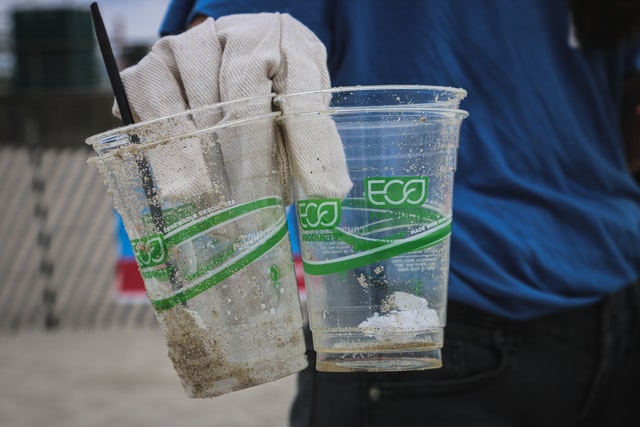
‘The phenomena of greenwashing’
Photo by Brian Yurasits on Unsplash
By Lois Hollingworth
In 2019, 60% of millennials said that they wanted to consume fashion more sustainably. This attitude is changing how brands and business are marketing their products in order to appeal to this sustainable outlook that many people are beginning to strive towards. However, creating sustainable fashion is considerably more expensive for businesses as it involves reducing the usage of cheap, fossil fuel synthetics such as polyester (which I will expand on later) leading to 60% of claims of sustainability by major fashion brands to be greenwashing- a new phenomena of marketing items as sustainable or recycled when the product is either made from as many fossil fuel synthetic materials as the original clothing lines[1].
H&M is one of the worst culprits of this with their “conscious collection”. It claims that “each conscious choice product contains at least 50% of more sustainable materials… but many contain a lot more than that”[2]. Even if we disregard the fact that 50% is still a significantly small amount sustainable material, the term “more” gives no definitive meaning as to what it is more than. This gives them leeway for these claims[3]. To further this, it was found that within the collection, one in five of the items that were analyzed “were made from 100% fossil fuel derived synthetics”. This is more fossil fuel synthetics than is in their normal collection[4].
Fossil fuel synthetics are fibres that made from unrenewable sources such as heavily processed crude oil and natural gases. To further the environmental impact during the production of these fibres, the resources used for making synthetic fibres are increasingly being obtained through fracking. This is the process of using high pressure water, chemicals and sand to open fissures within shale rocks in order to release trapped natural gas or oil. Fracking itself has many environmental problems such as chemical contamination into water supplies and increases seismic activity[5]. The main synthetic produced through these methods is polyester, the most used fossil fuel synthetic material which is made specifically from PET, a derivative of both crude oil and natural gas. Polyester is suggested to survive In landfill for over 200 years in which it will release methane and shed microfibres which inevitably end up in the ocean. In fact annually, the production of polyester alone releases 700m tonnes of CO2 which is equal to the CO2 output of 180 coal fired power plants and the general production of synthetic fibres uses about 350m barrels of oil which is 1.35% of the global oil consumption. More data on the use of fossil fuel based synthetics can be accessed here[6].
So considering how detrimental these synthetic fibres are to the environment, why are companies still using them in their more ‘sustainable’ clothing lines. This can be easily answered by considering profit. As is the nature of capitalism, companies are driven by profit and will do most things to increase this. This includes their marketing strategies and campaigns not fully capturing the full image of the actual line, as with greenwashing. As people become more concerned with their environmental impact, companies want to appeal to this in order to beat the competition and convince consumers to buy from not only the sustainable lines but also their brand in general as they ‘care about their environmental impact’. Hence, this ‘sustainable’ marketing ploy. It is then cheaper for a company to continue to use fossil fuel materials as these are easily obtained and significantly cheaper to produce than more renewable synthetics such as biosynthetics or natural materials such as wool. These can then be sold on for a higher price as companies are putting up this false pretence of them being better for the environment, and then worth the extra money to buy. This is manipulating consumers into paying more for products that are as equally harmful to the environment. Therefore, due to all of these factors, the profit for these companies is significantly increased as a result of greenwashing.
While there is an investigation going ahead by Watchdog right now, we, as consumers, have the most power when it comes to holding companies accountable for misleading campaigns and their environmental impact. While the most effective way to prevent greenwashing from brands is to boycott them entirely, this is more unsustainable and often too difficult for an ordinary person. There are still other ways to avoid greenwashed products such as looking for certification label, researching the brand that you are considering buying from or even just cutting down on your general consumption of clothing.
References
[1] http://changingmarkets.org/wp-content/uploads/2021/01/FOSSIL-FASHION_Web-compressed.pdf
[2] https://www2.hm.com/en_gb/customer-service/product-and-quality/conscious-concept.html
3 https://www.theguardian.com/fashion/2022/mar/11/greenwashing-uk-fashion-firms-to-be-named-and-shamed-by-watchdog
[4] https://www.theguardian.com/business/2022/jan/14/dirty-greenwashing-watchdog-targets-fashion-brands-over-misleading-claims
[5] https://www.britannica.com/technology/fracking
[6] http://changingmarkets.org/wp-content/uploads/2021/01/FOSSIL-FASHION_Web-compressed.pdf

0 Comments